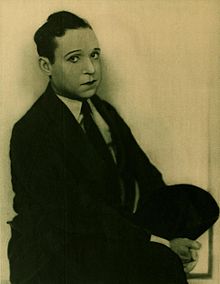Harry Langdon
| Harry Langdon | |
|---|---|

Langdon in Motion Picture Classic, 1926
|
|
| Born |
June 15, 1884 Council Bluffs, Iowa, U.S. |
| Died | December 22, 1944 (aged 60) Los Angeles, California, U.S. |
| Occupation | Actor, comedian |
| Years active | 1903–1944 |
| Spouse(s) | Rose Francis Musolff (1903–1928) Helen Walton (1929–1932) Mabel Sheldon (1934–1944; 1 son: Harry Philmore Langdon Jr., born December 16, 1934) |
Harry Philmore Langdon (June 15, 1884 – December 22, 1944) was an American comedian who appeared in vaudeville, silent films (where he had his greatest fame), and talkies. He was briefly partnered with Oliver Hardy.
Born in Council Bluffs, Iowa, Langdon began working in medicine shows and stock companies while in his teens. In 1906, he entered vaudeville with his first wife, Rose Langdon. By 1915, he had developed a sketch named "Johnny's New Car," on which he did variations in the years that followed. In 1923, he joined Principal Pictures Corporation, a company headed by producer Sol Lesser. He eventually went to Keystone Studios, where he became a major star. At the height of his film career, he was considered one of the four best comics of the silent film era. His screen character was that of a wide-eyed, childlike man with an innocent's understanding of the world and the people in it. He was a first-class pantomimist.
Most of Langdon's 1920s work was produced at the famous Mack Sennett studio. His screen character was so unique and his antics so different from the broad Sennett slapstick that he soon had a following. Success led him into feature films, directed by Arthur Ripley and Frank Capra. With such directors guiding him, Langdon's work rivaled that of Charlie Chaplin, Harold Lloyd, and Buster Keaton. Many consider his best films to be The Strong Man (1926), Tramp, Tramp, Tramp (1926), and Long Pants (1927). Langdon acted as producer on these features, which were made for his own company, The Harry Langdon Corporation, and released by First National. After his initial success, he fired Frank Capra and directed his own films, including "Three's a Crowd", "The Chaser", and "Heart Trouble", but his appeal faded. These films were more personal and idiosyncratic, and audiences of the period were not interested. Capra later claimed that Langdon's decline stemmed from the fact that, unlike the other great silent comics, he never fully understood what made his own film character successful. However, Langdon's biographer William Schelly, among others, have expressed skepticism about this claim, arguing that Langdon had established his character in vaudeville long before he entered movies, added by the fact that he wrote most of his own material during his stage years. History shows that Langdon's greatest success was while being directed by Capra, and once he took hold of his own destiny, his original film comedy persona dropped sharply in popularity with audiences. This is likely not due to Langdon's material, which he had always written himself, but due to his inexperience with the many fine points of directing, at which Capra excelled, but at which Langdon was a novice. On the other hand, a look at Langdon's filmography shows that Capra directed only two of Langdon's 30 silent comedies. His last silent film, and the last one Langdon directed, "Heart Trouble", is a "lost film", so it is difficult to assess whether he might have begun achieving a greater understanding of the directorial process with more experience. The coming of sound, and the drastic changes in cinema, also thwarted Langdon's chances of evolving as a director and perhaps defining a style that might have enjoyed greater box office success.
...
Wikipedia
